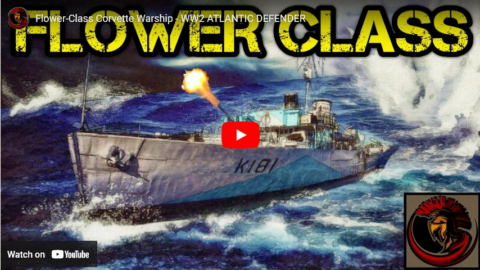Matsimus
Published 29 Jun 2020The Flower-class corvette (also referred to as the Gladiolus class after the lead ship) was a British class of 294 corvettes used during World War II, specifically with the Allied navies as anti-submarine convoy escorts during the Battle of the Atlantic. Royal Navy ships of this class were named after flowers, hence the name of the class.
The majority served during World War II with the Royal Navy (RN) and Royal Canadian Navy (RCN). Several ships built largely in Canada were transferred from the RN to the United States Navy (USN) under the lend-lease programme, seeing service in both navies. Some corvettes transferred to the USN were manned by the US Coast Guard. The vessels serving with the US Navy were known as Temptress and Action-class patrol gunboats. Other Flower-class corvettes served with the Free French Naval Forces, the Royal Netherlands Navy, the Royal Norwegian Navy, the Royal Indian Navy, the Royal Hellenic Navy, the Royal New Zealand Navy, the Royal Yugoslav Navy, and, immediately post-war, the South African Navy.
After World War II many surplus Flower-class vessels saw worldwide use in other navies, as well as civilian use. HMCS Sackville is the only member of the class to be preserved as a museum ship. Flower Class corvettes were originally intended for coastal escort and mine clearing work. Derived from a whaler design, they were simple, highly seaworthy vessels that could be constructed in secondary yards. The dire lack of ocean escorts early in the war necessitated their being used to screen convoys traversing the North Atlantic between Nova Scotia and the UK. This was a role for which they were ill-designed, and their crews suffered accordingly. The Flowers were wet, highly cramped and impossibly lively. Many sailors could not adjust to the exhausting routine. Compounding the misery was the inexperience of the crews, most of whom had never been to sea. But any escort was better than none at all, so the yards continued to turn out corvettes. 120 were built in Canadian yards, and slightly more in the UK.
References:
Bailey, C. H. (1994). The Royal Naval Museum Book of the Battle of the Atlantic: The Corvettes and Their Crews: an Oral History. US Naval Institute Press.
Elliott, P. (1977). Allied escort ships of World War II: a complete survey. US Naval Institute Press.
https://en.wikipedia.org/wiki/Flower-…
https://www.hazegray.org/navhist/cana…
https://www.historylearningsite.co.uk…
https://www.historylearningsite.co.uk…
Lambert, J., & Brown, L. (2010). Flower Class Corvettes. Pen and Sword.
February 19, 2023
Flower-Class Corvettes – WW2 Atlantic Defender
Comments Off on Flower-Class Corvettes – WW2 Atlantic Defender
No Comments
No comments yet.
RSS feed for comments on this post.
Sorry, the comment form is closed at this time.




